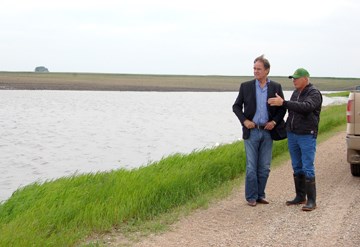With the wettest spring in over 100 years bringing seeding to a standstill in the area, farmers in the Humboldt region are waiting for a government response.
On June 18, Dwain Lingenfelter, Leader of the Official Opposition, was just north of Englefeld visiting the farm of Ken and Craig Crone.
The Crones, a father and son, only got 21 per cent of their spring seeding done this year before calling it quits. The Crones have had 13.5 inches of rain since April 1.
Craig, who ran into Lingenfelter at the Western Canada Farm Progress Show in Regina, invited him out to their farm to see the flooding caused by rain.
Lingenfelter told the small group gathered at the Crones' farm that he is continuing to push the federal and provincial governments for $100 per acre payments for unseeded and unestablished and flooded crop land.
"In the middle of a billion dollars for security on one conference in Toronto, if you compare that to this, there should be a billion dollars for this," he said of the flooding in Saskatchewan.
Lingenfelter urged the farmers to talk to their MPs and their MLAs and ask for government support.
"You need to explain the situation and make a request," he said.
Lingenfelter warned the farmers to ask for a direct payment for the flooded crop.
"If they say they want to put the money through the Ag Stability plan, everyone knows that's code for not getting any money," he explained.
Lingenfelter estimates that 12 million acres aren't seeded or have lost a crop across the province. That's $3.5 to $4 billion evaporated out of the Saskatchewan economy, he said.
The situation looks worse from the air, Lingenfelter noted, with the vast areas of flooded land much more visible.
Probably 28 per cent of the fields are seeded in the east central and north east region, and of that 50 per cent has probably been flooded out, he estimated.
"Where farmers are really losing money is where they seeded and then don't get anything," Lingenfelter said.
Craig Crone says it would be nice to have an announcement on government support.
"It's far worse than everyone standing here today," he said of the situation. "It's two to three billion dollars out of the Saskatchewan economy. It's gone."
Barry Eggerman, a farmer with land in the RM of St. Peter and the RM of Spalding was one of those in attendance at the informal gathering.
Eggerman got about 40 per cent of his crop seeded this spring, but he's done now.
"Even the stuff I got in, I don't know if it pays," he said.
Eggerman started seeding on May 15 and some of that has been flooded. He estimates that at least 20 per cent of his land is under water right now.
Eggerman is hoping there will be some government support for farmers hit hard by the flooding.
"It's not a small area affected like in 2006, it's a huge area," he said.
Lingenfelter is also calling for a pool of money for infrastructure needs in RMs affected by flooding.
"You can see roads with ruts and no gravel and they are starting to punch through the clay cap," he said. "It will take serious work to fix this. The need is urgent."
Eugene Eggerman, Reeve of RM of Spalding, was at the meeting. Eggerman has been farming in the area for 33 years and has never seen it this bad.
"I'm saying 30 per cent (seeding) got done this year," he said of the RM. "Personally, I'm less than 20 per cent."
Spalding is one of the RMs that has declared an agricultural disaster area and has applied for the Provincial Disaster Assistance Program (PDAP).
"It's getting beyond agriculture. It's also getting to be the roads and stuff. It's becoming impossible to keep them in relatively good shape," Eggerman said.
The high water levels and continuing rain is making it impossible for RMs to maintain the roads or do any of the road construction they had planned for this year.
"If we have to regravel even half of our roads, that's going to up our gravel bill by at least 75 per cent," he explained.
RM of St. Peter reeve Danny Breker was also at the event. They've also declared an agricultural disaster area and applied for PDAP funding. Breker had just over 15 inches of rain since the end of April.
"It's tough for a basement to go under water, and that can be fixed, but this is millions and millions of dollars that are just gone through nobody's doing," he said.
Seeding rates across St. Peter range between 30 and 40 per cent, but now 25 to 30 per cent of that is under water, he said. Breker got about 40 per cent of his land seeded, but much of that is now under water.
The RM is having a tough time maintaining their roads, he noted. The roads are losing gravel and are getting soft in the middle, he explained. There haven't been any washouts, but the roads are getting worse with every rain.
Breker is hoping that PDAP sends inspectors out while the water is still causing flooding.
"We've taken lots of pictures, but if they come out in two or three weeks, there won't be anything for them to see," he stated.
Over 40 RMs have declared an agricultural disaster area and/or applied for PDAP funding.
The Crones held the event to make people aware that the farmers have a disaster on their hands. Ken is hoping that the government will make an announcement soon about emergency funding, so people can start planning on how to pay their bills.
"Everything, all the businesses are going to suffer if something doesn't come out of it," Ken said.




